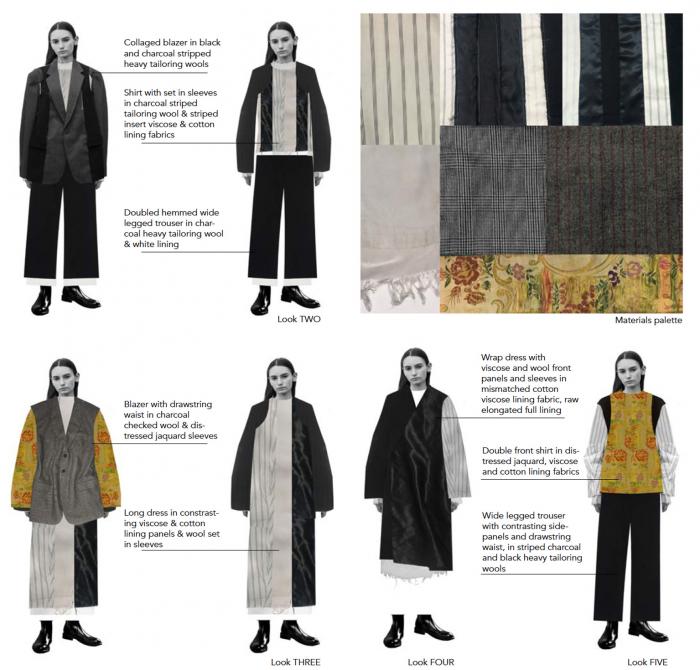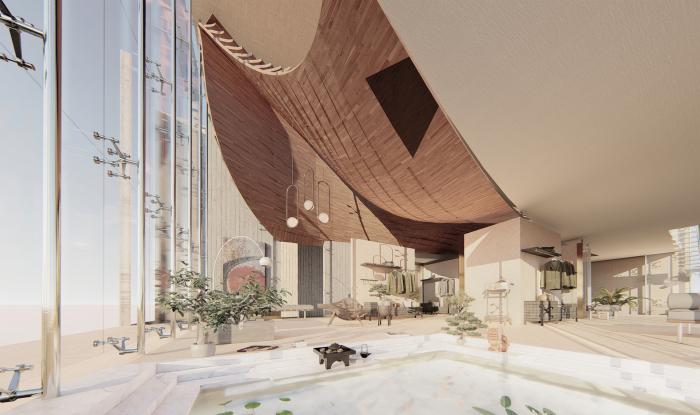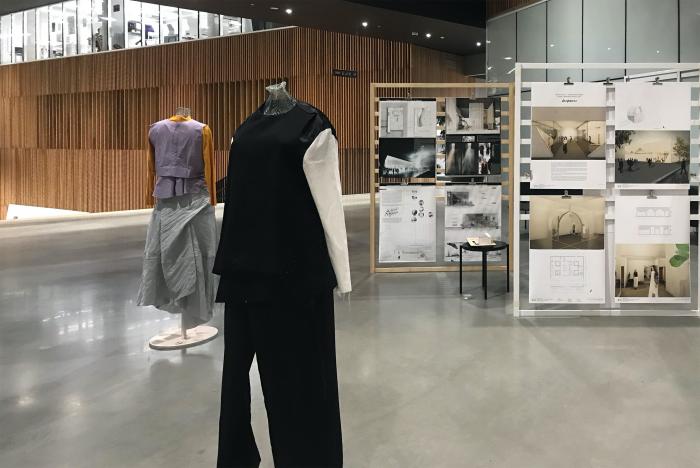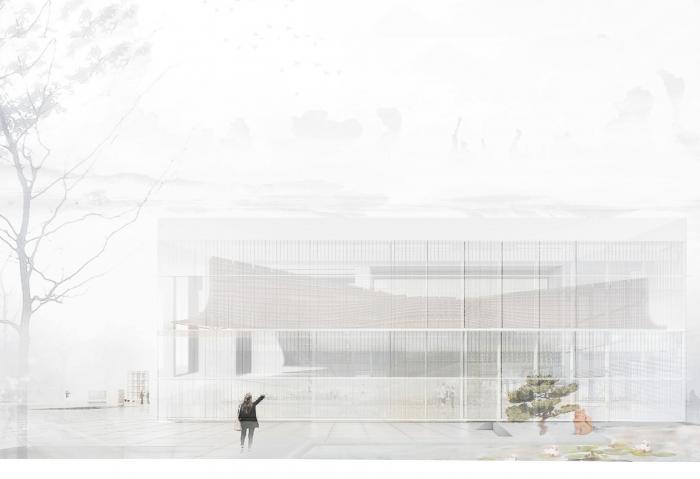I. SUMMARY INFORMATION
Project
268399
Status
Submitted
Award category
Interdisciplinary education models
You want to submit
NEW EUROPEAN BAUHAUS AWARDS : existing completed examples
Project title
Sustainable fashion+architecture
Full project title
Sustainable fashion and architecture interaction
Description
This is a model and a method of interdisciplinary education in the higher education that integrates the values of sustainability, inclusion and aesthetics in the content of the curricula and the learning process in art and design. The challenge was the sustainability and inclusiveness of fashion culture and its implementations comprehensively for branding in clothing, interior design and architecture, empowering urban communities and solving local challenges in the society simultaneously.
Where was your project implemented in the EU?
Finland
Uusimaa
Aalto University, PO Box 31000
60.18569933828709
24.824387885783164
Aalto
00076
When was your project implemented?
Has your project benefited from EU programmes or funds?
No
Which programme(s) or fund(s)? Provide the name of the programme(s)/fund(s), the strand/action line as relevant and the year.
II. DESCRIPTION OF THE PROJECT
Please provide a summary of your project
This is an inspiring model and method of education in the higher education of art that integrates the values of sustainability, inclusion and aesthetics in the curriculum and in the learning process. The challenge approached was the sustainability and inclusiveness of fashion culture and its implementations for a brand comprehensively in clothing, interior design and architecture, empowering local urban communities and solving local challenges in the cities and in the society simultaneously. The empowerment materialises in the concepts of 1) combining the development of the fashion brands to women’s empowerment and 2) the possibility of a fashion store or a flagship building to work simultaneously as a local community centre. The project is an innovative model of co-creation within the creative fields based on the interdisciplinary integration of science (sustainable material science and engineering), arts (architecture, interior design and fashion design) and social studies (cultural anthropology and trend forecasting).
The implementation in real context took place between a cross-disciplinary design studio course arranged at the school of Arts, Design and Architecture in Aalto University (AU) with the fashion brand Deepmoss and many supporting experts from the fashion and design industries. The students came from the three different degree programmes: Architecture, Interior Design and Fashion Design. A collaboration between these three fields is internationally groundbreaking. The course aims to become reorganised repeatedly.
Project lead
Antti Ahlava, professor, Department of Architecture, AU
Pirjo Hirvonen, professor of practice, Department of Design, AU
Project group
Laura Juslin & Lilli Maunula (Juslin-Maunula fashion brand, Helsinki), Tiina Rytkönen (JKMM Architects, Helsinki), Natalia Vladykina, Andrea Esquivel Velázquez
Specialists: Martti Kalliala (Nemesis Global branding and forecasting), Anna-Mari Almila (fashion sociology).
Please give information about the key objectives of your project in terms of sustainability and how these have been met
The key challenge is the un-sustainability of fashion industry.
The other main challenge approached here is the difficulties fashion companies have in their strategic and integrative development, when all of its activities become under one strategy and brand.
We created a cross-disciplinary, academic collaboration project on sustainable fashion in education, aiming to develop sustainable and integrative models for the industry.
The project targeted especially the integrative, sustainable production of fashion clothing, fashion stores and the flagship buildings of fashion companies.
We contributed essentially to the development of sustainable strategies and brands in fashion.
We were able to produce remarkable results in the exploration of the use of sustainable materials and principles in spatial and clothing design.
Please give information about the key objectives of your project in terms of aesthetics and quality of experience beyond functionality and how these have been met
The integrative aesthetic possibilities in the cross-disciplinary collaboration between the students of architecture, interior design and fashion design were worked on with mixed groups of students coming from their different disciplines and supported by experts from architecture, interior design, fashion design, fashion branding and forecasting and the sociology of fashion. This produced imaginative, new formal thinking, where the same concepts were implemented through different design disciplines.
We studied the aesthetic potentials of sustainable materials and solutions in spatial design and clothing design for fashion-related spatial design. Especially the utilisation of wood-based materials and durable, recyclable materials (such as stone) proved fruitful.
The study of the promotion of sustainable life styles within fashion industry resulted with prototype solutions for clothing (capsule collections), interiors (for stores) and buildings (flagships). These form an integrated whole for a fashion brand, emphasising all-encompassing social and ecological sustainability in the lifestyle they promote.
Sustainable, long-lasting fashion design cannot be anymore considered to be just clothing made of sustainable materials and with sustainable processes. We showed, how it can be a more comprehensive philosophy guiding all activities of a fashion brand.
Please give information about the key objectives of your project in terms of inclusion and how these have been met
We empowered the urban communities where the fashion stores / the flagship buildings of fashion companies designed are located. This was possible through the design process (interviews) and especially through the modifications and innovations in the spatial programmes of the flagship stores, which has the ability to empower local communities where the spaces are located.
We empowered women through the development of a more responsible fashion culture. This was made possible with the new concepts for space and their use that we created, and with the new empowering capsule collections of the fashion designs by the fashion design students.
We wanted to find design models and concepts for empowering the design communities in guiding the fashion companies towards the sustainable direction. In this pursuit, we made many innovations (sustainable physical brand management, comprehensive design management, cross-disciplinary co-creation and o-design) and generated many new, feasible ideas for implementation (new social and empowering activities, inclusive organisation and use of spaces and new materials in this genre).
Co-creation with fashion companies and with professionals from the three fields created pragmatic, but remarkably imaginative results as a result of a widened design community.
Please give information on the results/impacts achieved by your project in relation to the category you apply for
We created an innovative education model (a cross-disciplinary design course in collaboration with several fashion companies) and a method (comprehensive brand design) that integrates the values of sustainability (materials, construction techniques), inclusion (women's empowerment and local engagement) and integrated aesthetics in the content of the curricula of architecture, fashion design and interior design and in the learning process of designers working in the real world. The project also produced an innovative model of collaborating with fashion companies at a university, based on the interdisciplinary integration of science (sociology and the sustainable material science and engineering), arts (architecture, interior design and fashion design) and further social studies (cultural anthropology and trend forecasting).
Partners in the collaborative co-creation process
Local citizens interviewed on streets
Deepmoss fashion brand
Juslin-Maunula fashion brand
Nemesis Global trend forecasting company
Shanghai International College of Fashion and Innovation (SCF)
Course students
Architecture: Molly Mii Ekholm, Belén Germán Blanco, Laura Hetzel, Marcos Reyes Sanz, Yllka Kuçuku, Yu Zhang, Chen Zhuo, Amir Hossein Teymourtash, Anna Brandl, Moritz Wiedenmann
Interior Design: Dayoung Song, Lingfang Shen, Stiina Ruusuvuori, Laura Heino, Soroush Kalatian, Xiao Mou
Fashion Design: Ines Kalliala, Karolina Januleviciute, Anna Sarasoja
Please explain the way citizens benefiting from or affected by the project and civil society have been involved in the project and what has been the impact of this involvement on the project
Community participation: interviews of locals on the street on the sites of the design task, contributing to the design principles and the spatial programming of the spaces
An exhibition of the end results for the general public placed the results of the project on display publicly
Communication through web platforms reached a large number of interested people
Book publication and its dissemination spread information on the relults of the project especially to the professional and academic circles.
Please highlight the innovative character of the project
We present a groundbreaking method of integrating spatial and clothing design under the umbrella of sustainability and responsibility.
The brand new idea is to turn the typologies of fashion stores and flagship buildings into experimental laboratories for sustainability
Please explain how the project led to results or learnings which could be transferred to other interested parties
The students came from the three different degree programmes of Architecture, Interior Design and Fashion Design. The collaboration with these thee fields is internationally revolutionary. The course aims to become reorganised repeatedly and appears to be attractive to fashion companies everywhere as a tool to develop and test new sustainable and integrative activities and approaches.
--------------------------------------------------------------------------------------------------------------
Image credits:
1 Ines Kalliala, Aalto Universitry
2 Karolina Januleviciute, Aalto University
3, 4, 6 Amir Teymourtash, Aalto University
5 Antti Ahlava
Is an evaluation report or any relevant independent evaluation source available?
No
III. UPLOAD PICTURES
IV. VALIDATION
By ticking this box, you declare that all the information provided in this form is factually correct, that the proposed project has not been proposed for the Awards more than once under the same category and that it has not been subject to any type of investigation, which could lead to a financial correction because of irregularities or fraud.
Yes





